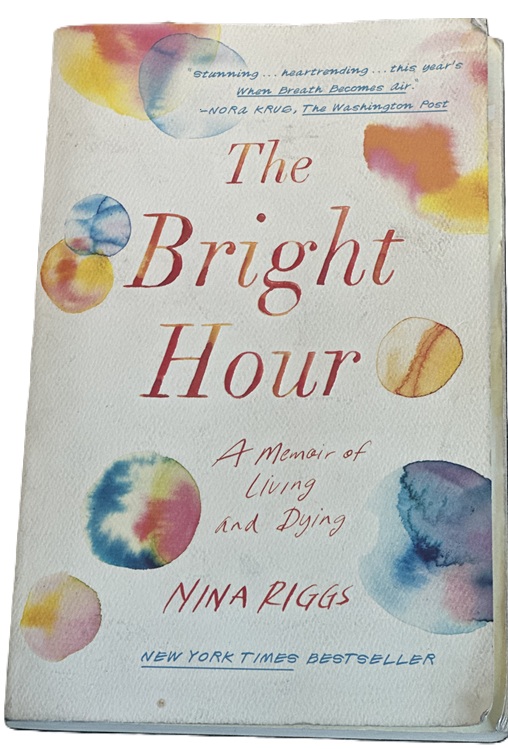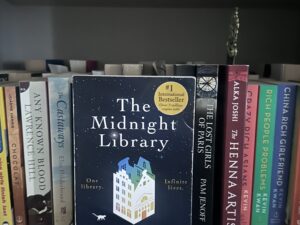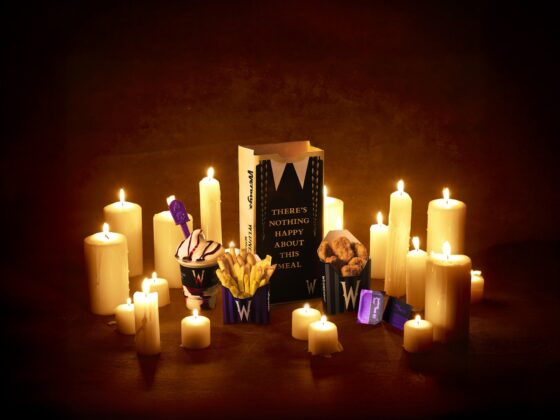The Bright Hour – A Memoir of Living and Dying by Nina Riggs: About the Book*
An exquisite memoir about how to live—and love—every day with “death in the room,” from poet Nina Riggs, mother of two young sons and the direct descendant of Ralph Waldo Emerson, in the tradition of When Breath Becomes Air.
“We are breathless, but we love the days. They are promises. They are the only way to walk from one night to the other.”
Nina Riggs was just thirty-seven years old when initially diagnosed with breast cancer—one small spot. Within a year, the mother of two sons, ages seven and nine, and married sixteen years to her best friend, received the devastating news that her cancer was terminal.
How does one live each day, “unattached to outcome”? How does one approach the moments, big and small, with both love and honesty?
Exploring motherhood, marriage, friendship, and memory, even as she wrestles with the legacy of her great-great-great grandfather, Ralph Waldo Emerson, Nina Riggs’s breathtaking memoir continues the urgent conversation that Paul Kalanithi began in his gorgeous When Breath Becomes Air. She asks, what makes a meaningful life when one has limited time?
Brilliantly written, disarmingly funny, and deeply moving, The Bright Hour is about how to love all the days, even the bad ones, and it’s about the way literature, especially Emerson, and Nina’s other muse, Montaigne, can be a balm and a form of prayer. It’s a book about looking death squarely in the face and saying “this is what will be.”
Especially poignant in these uncertain times, The Bright Hour urges us to live well and not lose sight of what makes us human: love, art, music, words.
The Review

The Bright Hour – A Memoir of Living and Dying by Nina Riggs is often compared to Paul Kalanithi’s When Breath Becomes Air. I have read both books, and although they both deal with death, although both deal with death under similar circumstances—young, in their prime, struck down by cancer—this is where the comparison ends. Both are beautifully written but stand on their own merits and tell the story of their final days in a way that is tragically beautiful. An interesting note: Nina Rigg’s widower, John Duberstein and Paul Kalanithi’s widow, Lucy, found love with each other after their shared grief.
Nina Riggs’ writing is poetic, fitting for a descendant of Ralph Waldo Emerson. She casts a spell with her writing, making the book difficult to put down—until the end. As the reader knows, she doesn’t make it, and that impending finality makes the conclusion something to dread. Anyone who has experienced will find something to relate to in this book. Riggs lost her own mother to cancer as she fought her own battle. She faces a double grief—her mother’s death and her own impending loss—with brutal realism.
A book about dying can lapse into being maudlin, but Riggs never allows that to happen. It feels more like a love story for her family, giving her two young sons a sense of who their mother was. She continues to live during her health struggles. She travels, she writes and in an especially moving portion, she selects and then changes her mind about a couch that she can convalesce on and her family can enjoy after her death.
There are quiet moments when she realizes the brief discomfort that she brings to healthy people around her. There are moments when she realizes that she has to let her boys live, even though she won’t be there through all of their milestones. There are quiet moments with her father, her husband and her children. One of the saddest moments, aside from the book’s conclusion and afterward, is when the book club she shared with her late mother begins again—now with one less chair. It is those small moments that bring the reader insight into Riggs’ grief journey.
This beautifully written book isn’t a typical summer beach read. It isn’t even a new bestseller. It is, instead, a memoir that is a must read for those who want to understand the role of death in life and how to live with it.
*From the publisher





